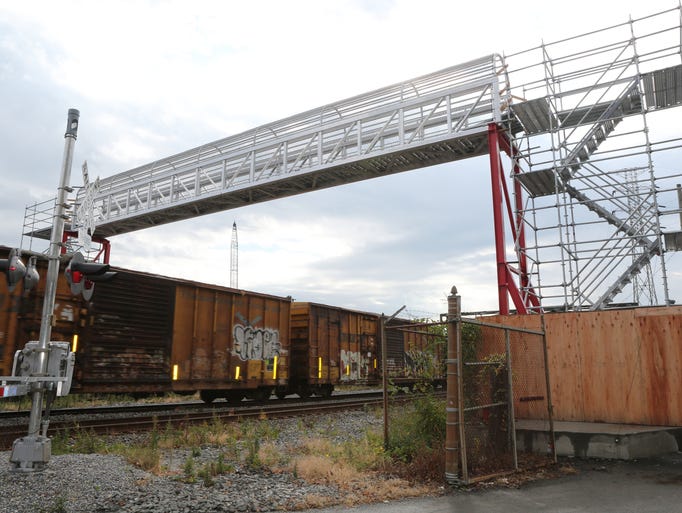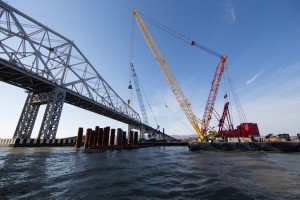Less than 15 miles from where the new Tappan Zee Bridge is being built, its steely skeleton is being put together. Dozens of workers are assembling fortified steel cages along the Hudson River.
STONY POINT – Less than 15 miles from the Tappan Zee Bridge, the steel skeleton of its replacement is being meticulously pieced together.
“The site is perfect,” Ro DiNardo, construction services manager for bridge builder Tappan Zee Constructors, said. “It’s 18 acres, and it has all the space we needed for these activities.”
For the first time, Tappan Zee Constructors on Tuesday offered a behind-the-scenes look at the bustling staging area at Tomkins Cove, a former power plant next to the Hudson River. DiNardo said its proximity to the bridge is saving time on the $3.9 billion replacement project, which is expected to be completed in 2018.
Here’s a breakdown of what’s happening on site:
Pile reinforcement
The estimated 1,000 hollow piles that are being set in the Hudson River are being fortified with cages made of reinforced steel, also known as rebar.
Bridge columns
Workers are also assembling cages that will ultimately become bridge columns. The steel structures are produced in a factory in New Jersey and dipped in hot zinc to strengthen them. The coiled-up steel is loaded on trucks and delivered to Tomkins Cove.
Using detailed diagrams, crews of five workers spend several days creating the sections, some of which are 20 feet long.
Then, DiNardo said, comes the tricky and most dangerous part: pouring the concrete into the mold that is built around sections of steel.
“We actually have to put men inside there so we can pour from the bottom and work our way up,” said DiNardo, of New City. “There are a lot of safety concerns. We have to have an entire plan together before we put anyone in there.”
Tower work
The structures that will be used to build the bridge’s eight towers are under construction at the site, too.
Each rectangular platform, known as climbing forms, has an opening in the middle where the concrete gets poured to create the towers in sections.
A hydraulic lift will raise the structure, with the platform eventually standing more than 30 stories above water.
“As we build, this will move with us,” DiNardo said of the platform.
The climbing forms are expected to arrive at the project site by barge in February.
Improved safety
Because the staging area sits next to an active railroad, the project team and railroad officials have had to make adjustments.
In the past few months, CSX freight trains were left unattended for up to two hours during crew shift changes, blocking emergency access to the site. In one instance over the summer, a worker who had an allergic reaction to something he ate, had to be brought by boat to a medical facility in Westchester.
Tappan Zee Constructors has just finished building a foot bridge over the tracks to allow emergency responders to reach the site by land.
The bridge builder expects to use Tomkins Cove through 2017. Eventually, the site will likely be used to demobilize cranes and other equipment when the work is done.
Fast facts
Tomkins Cove staging area: 18 acres
Workers: Approximately 60 not including subcontractors
Truck traffic: 5 to 20 per day
Barge traffic: 1 to 5 per day
Distance to Tappan Zee Bridge site: 14 nautical miles
Ask us about the Tappan Zee
When: Nov. 1 at 11 a.m.
Where: Pierson Park, Tarrytown
What: Journal News/lohud transportation reporters Theresa Juva-Brown and Khurram Saeed will answer questions and listen to comments about our Tappan Zee Bridge coverage. Join them for the informal chat over coffee and snacks.







